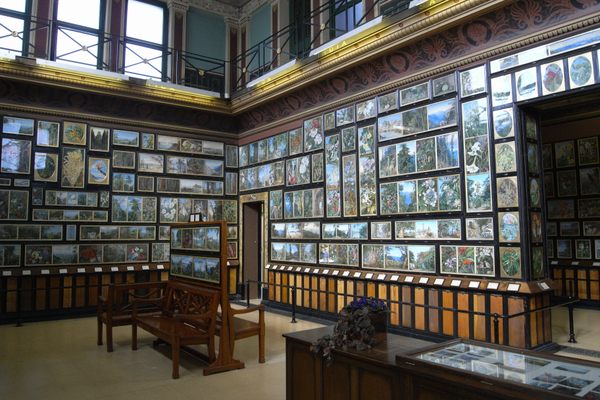The Radical Victorian Lady behind an Essential Collection of Botanical Art
The Marianne North Gallery at Kew Gardens (photograph by Jim Linwood)
Walking into the Marianne North Gallery is like entering a palace of color. The walls are plastered in vibrant greens, oranges, and fuchsias, jammed together in a luscious collage. Small squares of bright oil paintings line the doorways, luring visitors further inside.
Housed in a small building off a side path at the Kew Royal Botanic Gardens in London, the gallery was designed in 1882 by artist Marianne North and her friend, architect James Fergusson. Two full rooms display 833 botanical paintings created by North in her 13 years of travel around the globe, along with 246 different types of wood collected by North during her journeys.
Marianne North (courtesy A McRobb/RBG Kew)
North was an unusual woman for her time. She believed religion to be “mumbo jumbo,” marriage to be “a terrible experiment,” and travel companions to be “tiresome.” She was determined, energetic, ambitious and, according to her brother-in-law, “a little satirical.” This independent woman was the oldest daughter of a wealthy political family in London. When her mother died when she was 24, she was asked to look after her aging father. For the next 15 years, North remained unmarried and traveled extensively with her father in his work as a prominent member of Parliament.
When she was 37, North was introduced to painting and found it seductive and addictive, “like dram drinking,” she reported in her 1894 autobiography Recollections of a Happy Life, Being the Autobiography of Marianne North. When her father died a few years later, North was 39 and left without her confidante and good friend. She was also left in charge of a sizable inheritance, and soon decided to venture out on her own to document the world’s biodiversity with her easel.
Marianne North painting a Tamil boy in Ceylon (1877) (photograph by Julia Margaret Cameron)
She preferred to travel alone, though she carried plenty of letters of introduction to ambassadors and heads of state to ease her arrival in foreign lands. North traveled to 16 countries on six continents and lived a life free of the societal pressures of a typical upper-class woman of the day, preferring huts or locals’ homes to fancy hotels. Crossing raging rivers, traveling at top speed on donkey carts, traversing mosquito-infested jungles — nothing stopped this woman from getting the most unusual specimens for her work. And she painted feverishly, producing over 1,000 pieces of art.
What made North special, in addition to her utter lack of formal art training, was her preference for working in the environment where her specimens appeared naturally. She captured each plant where it grew, often including more than one species in a painting.
“Honeyflowers and Honeysuckers” (1882), South Africa (via WikiPaintings)
“The Aqueduct of Morro Velho” (1873), Brazil (via WikiPaintings)
When she exhibited in London in 1879, her full-color paintings exploded on the art scene, bringing to adventure-hungry city dwellers the lush hues and textures of the tropics, deserts, and mountains. Soon after, the always-ambitious North asked Sir Joseph Dalton Hooker if she could donate a permanent exhibition hall to Kew Gardens in order to display her paintings. Hooker agreed. Once the gallery was built, North arranged the drawings by hand according to geographic location. (The Marianne North Gallery is still the only permanent solo exhibition by a female artist in Great Britain.)
Entrance to the Marianne North Gallery (photograph Jim Linwood)
The Marianne North Gallery (photograph by Heather Cowper)
North’s legacy was clear even in her own time. Sir Hooker proclaimed her collection to be an important record of soon-to-be extinct species, and Charles Darwin, a family friend, requested she document the flora of Australia, New Zealand, and Tanzania to fill out her collection (which she did, despite her failing health). Though her lifestyle was controversial in her time, her work continues to be one of the world’s most important collections of historic botanical art. Four species are named in her honor.
Marianne North died in 1890 at the age of 59. Though the gallery was renovated in 2009, the paintings remain displayed exactly as North intended, creating a lively jamboree of color and shapes that celebrate the incredible diversity of the world’s plant life, and the incredible accomplishments of this determined woman.
Pitcher plants of Borneo (1876) (via Wikimedia)
Recommended further reading: Abundant Beauty: The Adventurous Travels of Marianne North, Botanic Artist from Greystone Books.




























































Follow us on Twitter to get the latest on the world's hidden wonders.
Like us on Facebook to get the latest on the world's hidden wonders.
Follow us on Twitter Like us on Facebook